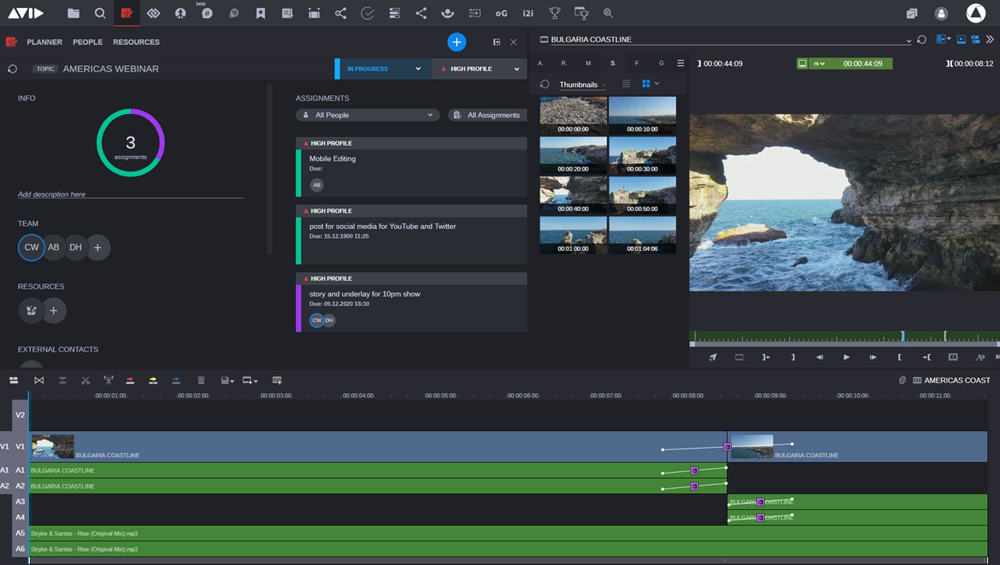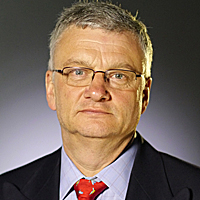
‘Once Adopted, There’s No Turning Back’ For Cloud’s Use In Field Production

Two years after the COVID-19 pandemic turned the world upside down in March 2020, a return to normalcy is finally at hand as mask mandates and vaccine requirements across the U.S. and many other countries are steadily being rescinded. The television industry seems to have returned to normal, too, with newscasts originating from traditional studios instead of living rooms and the industry readying to gather once again at the NAB Show in Las Vegas next month.
However, technology vendors say that the shift to remote news production that occurred out of necessity during the early days of the pandemic is still persisting out of choice in 2022 for many stations and networks.
A good chunk of news has always been produced remotely, of course, with reporters and videographers heading into the field to cover breaking events. But advances in technology such as remote desktop access and cloud-based editing now allow producers, editors and other staffers to perform key functions at home that they previously did onsite. And many are continuing to work remotely, at least part of the time.

Paul Adrian
“The predictions of a mass running back to the studios didn’t come true in the way that some broadcasters envisioned them,” says Paul Adrian, CEO of file delivery specialist Latakoo.
There are a number of reasons for that, with the biggest being COVID-19 variants like Delta and Omicron that kept staffers out of newsrooms throughout last fall. And Adrian concedes that anchors and other on-air talent have returned to studios. But in terms of using cloud-based delivery systems, he said Latakoo is “not seeing a retraction at all.”
IP Use Continues To Rise
In fact, the company actually showed more usage for its IP delivery platform in 2021 compared to 2020, when its numbers had already dramatically jumped compared to the previous year. And while many customers told Latakoo they expected their usage to drop in 2022, the company is instead seeing it continue to increase.
“Potentially that means they’re still doing a lot of stuff in the field,” Adrian says. “Also, part of it is that Band-Aid ripping off in terms of adopting cloud workflows. And once adopted, there’s no turning back.”
Remote Interviews Commonplace
Bonded cellular vendor LiveU specializes in live backhauls from the field but was employed as a home studio contribution system by some stations during the pandemic. While most on-air talent at its customers have returned to the studios, LiveU also isn’t seeing a wholesale change back to pre-pandemic workflows, says VP of Engineering Dan Pisarski.

Dan Pisarski
In particular, he notes that many stations continue to rely on remote interviews of guests from their homes, using cloud-based videoconferencing platforms like Zoom, instead of bringing them into the station or a third-party physical studio. And that practice is now widely accepted by audiences.
“Overall, we’ve seen very little shift back, where it’s ‘Whew, glad that’s done. Let’s go back to the way we were working before’,” Pisarski says.
He adds that internet connectivity and transport protocols have improved to the point where latency is no longer an impediment to “ground to cloud” or “cloud to ground” workflows, including editing. While he doesn’t see much cloud-based news production today, he says some big news customers are contemplating moving all of their production to the cloud and doing away with local facilities entirely.
Work From Home Endures
Like other industries wrestling with the question of how many workers will return to the office five days a week in the long term, broadcasters are considering their employees’ work-life balance and assessing their long-term real-estate needs. For many stations, that means that some staffers will only be onsite a few days a week going forward and will skip long commutes and work from home the rest of the time.

Craig Wilson
Craig Wilson, Avid product evangelist for media and cloud, estimates that 30% to 40% of news personnel who were onsite in 2019 before the pandemic are still working from home. Many of those staffers might be producing content for a station’s digital desk, while personnel working on the on-air broadcast are more likely to be back in the studio. But with the ability to use traditional on-premise editors like Media Composer from home through remote desktop systems like Teradici, as well as Avid’s new cloud-based Avid | Edit on Demand system, those distinctions are blurring.
One large Avid customer is considering reducing its office space by 50%. Instead of having a lot of physical infrastructure onsite in the station, it plans to have its computing hosted in the cloud or in a remote data center. And rather than building 20 edit suites in a fixed facility, it’s aiming to have editors use Media Composer remotely over a Teradici client.
Remote access into systems through tools like Teradici has been available for some time, but news personnel simply didn’t take advantage of it before because they could come into the office. That changed with the pandemic.
The rise of cloud technology such as Edit On Demand, an entire editing and storage system hosted on the Microsoft Azure cloud, has also made content sharing easier and rendered the user’s location largely irrelevant (while Edit On Demand isn’t yet being used for daily news production, it has gained significant traction in entertainment production, embodied by a recent agreement between Avid and Paramount Global). At the same time, Wilson says in-person interaction in the newsroom is still valuable in producing the end product.
“I think everyone is still struggling to find what that balance is,” he says. “The simple fact that you can do your work from home doesn’t ultimately mean that that’s what you should be doing all of the time.”
To help foster communication between onsite and remote staff and better support “story-centric” multiplatform production, Avid has developed a tool called Media Central Collaborate that encompasses planning, assignments, task management and project tracking. It can be accessed on a web client, through a mobile app and also through the Media Composer and Adobe Premiere editing systems.
“It’s trying to find that way of bringing all the teams together, so you have one place where you can see all the assignments and the tasks and the updates on stories,” Wilson says.
Virtualizing The Station’s Walls

Sam Peterson
Bitcentral has seen a significant change in the way its customers use its Oasis asset management and archiving system since the onset of the pandemic, with a lot more stations using the web-based remote contribution feature as a way for reporters to send packages back as files, says COO Sam Peterson. At the same time, use of the Create browser-based proxy editor also dramatically increased, as journalists working from home started using it to search the Oasis system for the source content to edited packages, with the goal of further repurposing.
“More and more of this is happening outside the walls of the station, and I don’t think it will ever go back the way that it was,” Peterson says. “The complication that that’s creating is the workflow related to the other content that maybe doesn’t get used the first time around.”
As Peterson explains, if an MMJ shoots 20 minutes of video and then edits it down to a 2:30 package, there might be 16 minutes of content that didn’t get used but wasn’t thrown away. In the past, other journalists at the station looking to produce a digital package or another broadcast segment on the same topic would access that source content through the local storage. But that stopped happening due to COVID, when those personnel were home.
The expanded use of Create created some challenges, as the system was initially intended for 10 to 20 journalists at a station to be able to do simple timeline editing of content without having to use a dedicated editor like an Avid Media Composer or Adobe Premiere. As such, it was designed to work over a LAN, not a WAN like the internet, and so the workflows had to be tweaked a bit.
“We’ve been working really hard with a couple customers in particular, so the station walls aren’t the station walls anymore,” Peterson says. “There’s very little that has to happen inside the station anymore. We’re trying to get those tools to be available everywhere.”
Like Avid, Bitcentral sees a hybrid model for archiving content being used by most customers going forward with a mix of on-premise and cloud storage, either public or private. For its part, Bitcentral stores the Oasis database with proxy video in the cloud, allowing federated search across large groups like Nexstar and Fox. Meanwhile, the hi-res material resides at stations on local storage.
Live And Distributed News Production In The Cloud

Trevor Francis
Another longtime news vendor embracing the public cloud is Grass Valley, which has been promoting its AMPP (Agile Media Processing Platform) system as a live production option in the cloud as well as a platform for distributed news production. While AMPP interfaces with GV’s own Edius editing system as well as Adobe Premiere, it also has its own HTML5-based proxy editor that runs in a web browser and is perfectly suitable for cutting two-to-five-minute news packages, says Trevor Francis, Grass Valley director of business development.
Edius has always had the dual capability of working with both low-resolution proxies and high-resolution media, and GV is bringing the same approach to AMPP. The notion is to keep cloud storage and egress costs low by working with proxies at an encoding rate of 1-3 Mbps. Ingesting the proxies into the cloud allows news and sports editors to immediately start working on a “growing file” from a live event. Then when they’ve winnowed through an hour or more of proxy video to produce a finished two-minute edit, they only have to render and transmit the final package in high resolution for broadcast.
“You don’t want to be shifting high-resolution content around any more than necessary,” Francis says. “AMPP’s strategy is to keep high-resolution content where it is, put the proxy where everyone can get at it and then only be moving tiny amounts of content that you decide to use to where you want to be. For example, you’ve got content in Los Angeles, say 100-200 Mps content, and you want to edit it in London and broadcast it in the U.K. You can edit the proxies, and then you’ve only got to bring two minutes [of hi-res video] across to London.”
Francis notes that the proxy video itself might be good enough for distribution to a social media platform like Facebook, in which case the edited package could be played right out of the cloud. Then a hi-res version could be rendered later if it also needed to be included in an on-air broadcast.
Another big advantage of the cloud for news production is the ability to leverage AI tools like speech-to-text or image recognition from players like Amazon, Microsoft or Google to take care of menial tasks and reduce the human workload, Francis adds.
“It facilitates a lot of things that can speed up human activity, because people don’t have to do really boring things like logging Parliament debates,” he quips.
































Comments (0)